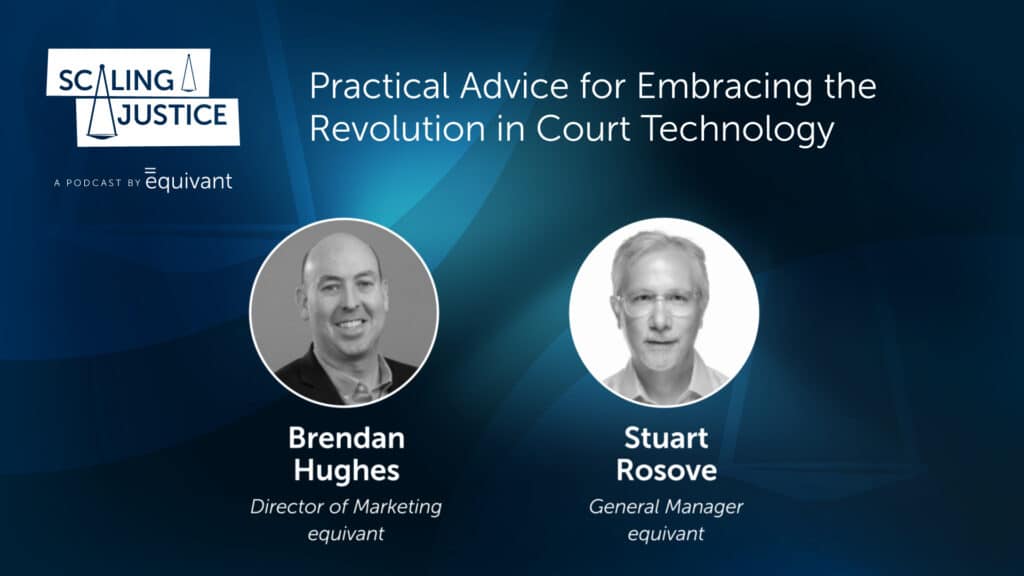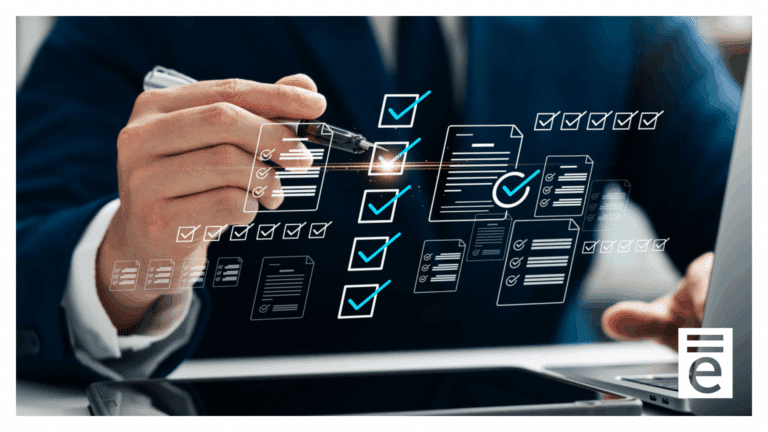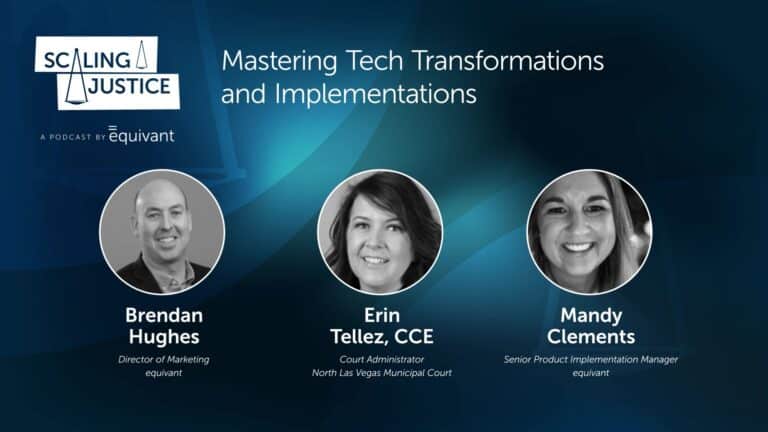Scaling Justice • An equivant podcast
In our latest episode of Scaling Justice, Brendan Hughes sits down with Stuart Rosove, General Manager of equivant Court, to discuss the truth about cloud/app-based technology and AI, and what court leaders need to know to modernize their court.
The introduction of new technologies and the explosion of AI have left some feeling overwhelmed and/or unsure of how to get started. In this podcast, we break down what we mean by “court technology revolution” and give you practical advice with actionable steps your court can take in both the short and long term.
Watch on YouTube:
Stream Audio Version on Simplecast.
Scaling Justice Podcast Transcript
Practical Advice for Embracing the Revolution in Court Technology Podcast
Brendan Hughes: Hello and welcome to Scaling Justice, a video podcast by equivant that operates at the forefront of the justice space. I’m Brendan Hughes, Director of Marketing at equivant. All of us here at equivant are dedicated to delivering innovative solutions to simplify justice and to help build more efficient and effective courts. Today’s topic is an important one. I think most of the people in the justice space probably acknowledge that we’re in the midst of a bit of a court technology revolution, or if they weren’t aware, they will be shortly. And that’s because we’re experiencing a major shift in the tech landscape. Outdated technology and old legacy systems have always been an issue in the justice space, but they’re beyond that tipping point now, and it’s really starting to become unsustainable moving forward. Cloud and app-based enterprise solutions have become more of a focus. A new generation of court staff are joining courts and justice spaces and they are tech immersed and they expect to live and work with modern technology.
And so you add in the rapid emergence of AI, it can be a lot for any justice leader to keep up with and make sense on what they should do moving forward. Luckily today, I asked Stuart Rosove, the General Manager at equivant Court to cut through the noise, the platitudes, and jargon and provide a practical understanding of the current court trends what court leaders should be doing now, and what they need to do to modernize their court. So welcome, Stuart. So Stuart, I know you have an extensive background in the justice technology space. Just to get us started, could you walk us through a little bit of your experience in this space?
Stuart Rosove: Sure. I’ve been involved in and around the space for the better part of 10 years. One of the first toes that I dipped into the market was working with a company called Mora, which arguably was the foundation company that created this whole space called online dispute resolution. Now, back then, the company was working both in the private and public sector, but ultimately was acquired by one of our competitors, Tyler Technology. And as a result, I was acquired into Tyler. I enjoyed a couple of years working at that company and then broke off onto my own and under my own consulting practice was retained by a couple of large private equity firms that were looking to roll up some of our competitors in the court and justice space. As part of that assignment, I actually got to look under the hood of some of our today competitors, looking at their shift to this very topic today and how they were managing this. This goes back three years ago, was probably some of the greatest insights I’ve gained by sitting sort of on that other side of the table and looking into the market space. And then I joined equivant court just about a year and a half ago.
Brendan Hughes: Great. Now, as you probably know from your extensive experience that courts have traditionally been a little bit slow to adopt new technologies, but this is often for good reasons. Can you provide some background on why you think maybe this time there’s a little bit more of a tipping point and it might be different than the way courts are evaluating their current technology?
Stuart Rosove: Sure. First, let’s qualify slow to adopt. You’re never going to find a court or a government agency for that matter that’s going to be at the absolute forefront of a technology adoption. And why? Because to run all of these systems, they require the most stable, the most tried and true systems out there, particularly when it comes to dealing with such sensitive information of our citizens. Why is it more of a tipping point today than ever before? There’s a whole host of reasons. First of all, and depending on which report you read or what data you get access to, the average age of a case management system in courts, both in Canada and the United States at the low end would be about 10 years old. I believe that that number’s probably closer to 20 or 25 years old. So these are systems that are using old frameworks.
They’re running on old hardware using a whole bunch of things that are not just outdated, but some of the vendors, particularly on the hardware side, no longer support that equipment. And so it’s becoming far more expensive to maintain and run those systems than ever before. Now today with the push towards modernization, thanks very much to covid when you think that during covid, we literally took not just our industry, but many industries and just advanced them, but 10 years forward and providing easier access, in our case, easier access to justice because the justice system couldn’t just close down and wait for everyone to get vaccinated and to heal. And so today, more and more courts are dealing with the legacy systems juxtaposed to great innovations around cloud computing, a greater sense of security around cloud computing and just the other benefits such as benefiting from economies of scale and so on.
Brendan Hughes: And then maybe talk about, because something I’ve been hearing more about is where client server, web-based technologies are starting to become out of favor. Why might that be?
Stuart Rosove: So here again, client-server technology typically on-premise web-based previously, and also for those of you that remember always called thin client, a lot of that computing power moved into the cloud, providing better architectures for better security, for better updates and less reliance on the IT staff, allowing IT staff to focus on more mission critical things than to make sure that the servers are up and running, that the coolant even think about the cooling systems to keep that equipment room at or below room temperature. In fact, look at equivant Court ourselves at our office in an older building. We did have a flood that took down some of our old client-server systems for about 10, 11 days. It’s just impractical. We can’t have that impact our customers. And so all of these courts are dealing with these type of real life, real world situations.
Brendan Hughes: And you touched on this a bit earlier, but new court staff, maybe younger court staff is starting to impact this and also this concept of self-represented litigants, easy for me to say, but those two concepts I think I’ve heard are starting to drive some of this.
Stuart Rosove: Sure. So let’s talk about court staff first. And I have not met one of our customers that has said, “Hey, Stuart, it is so easy to find people. People are lining up to come work for us.” It’s very challenging to find well qualified individuals to work at these courts. It’s even more challenging whether it’s at the court or at companies like equivant to find highly qualified individuals that understand 20-year-old technology, that universe of talent is shrinking. And so the net result is when you do find somebody, you’re going to pay a premium for that individual because of their albeit somewhat waning expertise in waning areas, but your costs are just going to get driven higher. And then you juxtapose that with, as you said, self-represented litigants. A couple of interesting facts, the number of self-represented litigants is on the rise in family law cases. One of the more recent studies suggest that 70% of every divorce at least one of the parties is self-represented mostly due to the cost of going through that process.
Whereas also in the real estate market, most tenants in eviction cases, we’re now seeing upwards of 90% of those people as being self-represented litigants. So more and more we’re seeing the citizens like you and I that aren’t going to the expense of hiring a lawyer or an attorney and are taking on the law and finding justice for themselves by representing themselves. It becomes even more interesting because wave of self-represented litigants have been living in the gig economy. The same person that is going through a divorce probably has a house full of smart technology, is ordering food by going to DoorDash, hopping on an Uber, booking things online that nobody contemplated 15 odd years ago. Then, when they then get faced with a 15, 20-year-old system and are trying to figure out how to navigate a rather non-intuitive system, the frustration level just increases. So the demand on the judicial system to modernize is just increasing with these type of pressures.
Brendan Hughes: Yeah, no, those are great points. And to the next question on top of all of that, you add into the mix this artificial intelligence revolution, like this idea of AI and it has a lot of promises around it, but for court leaders, justice leaders, what’s the real impacts of AI and what should they be kind of aware of right now?
Stuart Rosove: Sure. So the industry is a buzz with AI so much so that to me, there’s a lot of marketing jargon and promises around what artificial intelligence and its impact can be in the judicial system. The first point that I’ll make is that we as a company don’t believe that artificial intelligence is going to replace the mission critical workers in the courts today. So solid AI is not going to replace the judiciary, the attorneys, the clerks. What it’s going to do is provide assistance to these individuals to focus on the issues that matter. Taking that a step further, and when we talked about the self-represented litigants, artificial intelligence is fantastic at being assistive. It’s going to assist that self-represented litigant walk through the minefield, the twists and turns of a case to fill out the right forms, to provide the right information, to know where to look for the right data and to make their own justice journey a lot more palatable. That’s where the real impact is likely to happen in the next three to five years.
Brendan Hughes: Great. Yeah, and what’s interesting is that at this time, a lot of those Clerks of Court, the judges, the IT leaders, they’re faced with all of these challenges and understanding AI, being responsible for staff, the legacy systems. So all that swirling around them. What are some practical steps in the short term they should be doing now while facing all of this knowing that we’re at this tipping point?
Stuart Rosove: Yeah, so that’s a great question. There’s a couple of things that they should focus on. Right now is a fantastic to reevaluate their own workflow processes. Surprisingly, many courts have never documented their workflows. A new staff comes in and they usually have to shadow somebody to walk through the policies, the procedures, from everything from case initiation to docketing to financial reconciliation and so on, all the way through to the disposition of a case. So when considering what to modernize and what to automate, they should think about the way that they’re doing things today. Is it the most effective and efficient before they start evaluating technology. Then with that sort of in their back pocket, they can then start looking at the technology with a little caveat, which is when a vendor starts to sell you artificial intelligence, really dive deep into what that promise is and challenge if it’s really going to solve the business problem or the court management problem that you’re faced with today.
Brendan Hughes: That’s great. Yeah, and then obviously in these spaces, government agencies, courts making large decisions with lots of budget required. They’re not easy things. Those things don’t happen overnight, and so long term, what should they be focused on as they look to the future? Maybe they’ve taken your sage advice in the short term. What should they be thinking about in the long term?
Stuart Rosove: So we probably should have turned those questions around because when you’re looking at the short term issues, you’re trying to understand and to figure out whether you’re the most efficient you could be. For long term you want to ask what’s the ultimate state that you want to get to? And I’m not going to plant any ideas or suggestions because every court has their own nuances and desires. While most of them have the same constraints, budgetary and operationally, each of them have their own direction that they’d like to get into. So I think it’s important to sit down and imagine what does the court in the future look like? I would suggest they think about 10, 15 years out from today by using that as the goalpost going toward then the short-term decisions all the way down to what’s the type of data that we need? Do we have all of the data fields that we require, and where might that shift given the experience that we’ve had over the past 10, 15 years to make that ultimate leap into the future? So you’re setting yourself up for success rather than in five years going, oh, I’ve got to start fresh and get into all kinds of issues starting with data conversion and extraction from that current system into that next system.
Brendan Hughes: Great. Yeah, very practical advice, both in the short term and long term and much needed. I think at this point where we are in the space and all the buzz around AI and where things are going and the challenges that all the courts face, and as fast as technology changes, I think some of the items you just laid out are practical. Who’s to say what’s the next technology in five to seven years? Any predictions on that, Stuart?
Stuart Rosove: The next technology in the next five to seven years…
Brendan Hughes: Yes,
Stuart Rosove: I do believe that we’re going to see some additional jumps in cloud computing that we haven’t seen in a while, and that this notion of true app-based systems, and I’m not thinking of a marketplace per se, but more modular systems that a judge can use at any time from anywhere, same with a clerk, and same with the citizens. I think that we’re going to see a realization of that world in the next five to 10 years.
Brendan Hughes: Great. Yeah. Well, I appreciate you taking the time today. Again, a lot of great practical advice that people can take now and apply in the near term and the long term, and then be prepared for whatever comes in the next 5 to 10 years. So thanks again, Stuart, and I also appreciate everyone listening today in this edition of Scaling Justice, brought to you by equivant, and contact us at [email protected] to weigh in on this episode, or just let us know what topics you’d like to hear in the future. So until next time, I’m Brendan Hughes, and this has been Scaling Justice.





